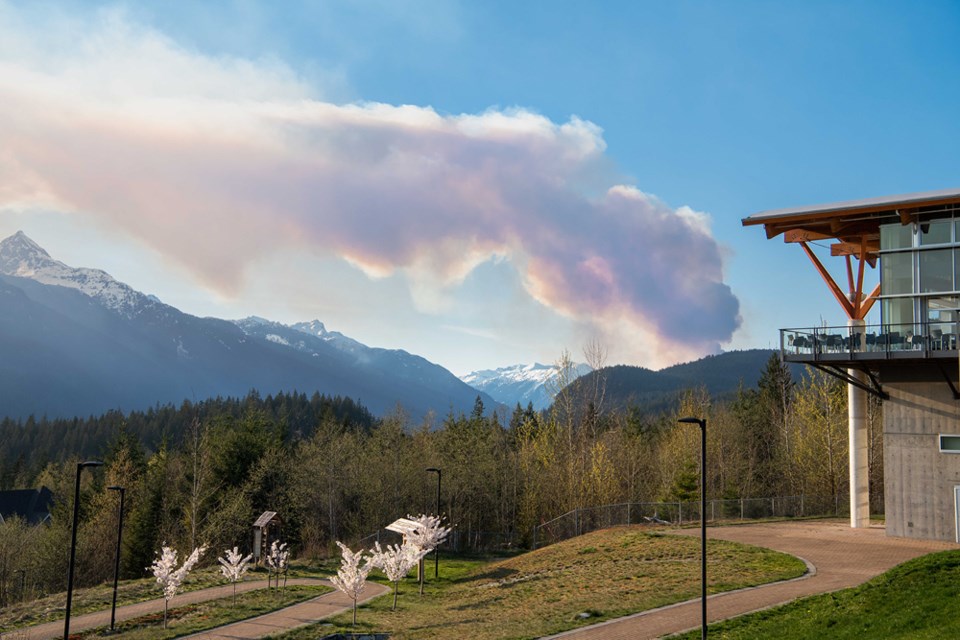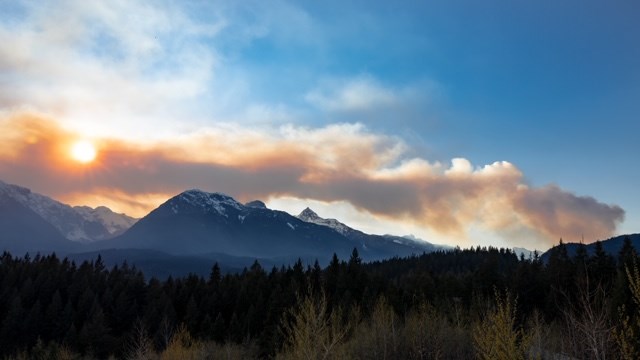Initial, rough estimates indicate that about three homes were destroyed and between 60 to 100 people have been displaced by the Squamish Valley fire.
Tony Rainbow, chair of the Squamish-Lillooet Regional District board, said that these numbers are still preliminary and subject to change.
There may have been more structures, such as sheds and barns that were also destroyed, he said.
Marg Drysdale, fire information officer at the Coastal Fire Centre told The Chief that new estimates show that the fire spans 203 hectares. The fire didn’t grow, but rather more accurate assessments have been made.
The wildfire continues to burn near Squamish. Air quality remains good but smoke may move overnight towards our region due to outflow winds. Fine particulate matter levels could be elevated overnight in Lions Bay, Bowen Island, parts of West Vancouver. https://t.co/Rc2gAF5HEf pic.twitter.com/ia78FrS0NZ
— Metro Vancouver (@MetroVancouver) April 17, 2020
She said today 46 firefighters are working the fire alongside four helicopters, three excavators, two structural protection units, and two danger tree fallers, who will cut down hazardous trees.
Generally, those numbers describe the firefighting crew from the province.
The SLRD has equipped about 20 volunteers to assist in battling the blaze. The District of Squamish’s municipal force is on standby to help at the moment, but contributed one of the two structural protection units.
Drysdale added temperatures are cooler Friday, April 17, and winds are down, so hopefully significant progress can be made.
“Crews are making very good progress,” said Drysdale. “Conditions are favourable today.”
She said the blaze is being characterized as between Rank 1 and 2. The former describes smokey ground, while the latter is characterized as smokey ground with occasional flames.
Rainbow added that the number of people displaced is still hard to figure out, as several people stayed in their homes despite the evacuations. Others also stayed to help fight the fire.
The next step is now to figure out how to house people that lost their homes.
At the moment, displaced people are being housed in hotels throughout Squamish and there are plans to house people in Whistler in case an overflow happens. However, there’s a time limit to how long they can stay.
Rainbow said the SLRD is working with landlords in the Squamish area to try and figure out long-term rentals for these people.
This will be especially important, given the challenges of finding housing on short notice in the middle of a pandemic.
So far, Woodfibre LNG could be one of the organizations helping out. The company is in talks about possibly renting its Sirocco apartment units out to displaced homeowners.
The company rented out some of the units in the downtown Sirocco building for its management staff during the construction of the project, but that has been put on hold due to delays. As a result those units have been freed up for one year.
"It's heartbreaking that these families have lost their homes - their safe places - during these difficult times,” wrote spokesperson Rebecca Scott. “Woodfibre is eager to help if we can."
Luckily, for now, hotel accommodations are allowing people from each household to have their own rooms, so social distancing can still be in place, Rainbow said.
“We’re certainly not just going to walk away from people and say, ‘You’re on your own,’” he said.
“What we’re hoping is to find accommodations that they can rent for as long as they need, so if you’re home’s been destroyed, it’s obviously going to be quite a time before you’re able to rebuild.”
And it’s not just people who’ve lost their houses that may be in need of longer term accommodations. Power lines were knocked out and could take weeks or months to re-establish. Some houses in the valley rely on electric well water pumps for their water, and until power is established, they won’t be able to return home.
“Even if the people still have their homes, it’s going to take a while before they can move back,” said Rainbow. “So it’s not just two or three homes we need — we need a lot more.”
The state of emergency that was enacted for the fire response will remain in place, Rainbow said. By default, a state of emergency lasts a week, and it will be extended until the SLRD determines that it’s safe enough for people to go to the area.
But in the immediate future, Rainbow said he hopes people will keep out.
“If we can...extend [the state of emergency] for a few more weekends...because we really do not want people to take a look and see what’s happening,” he said.
With respect to the Squamish Nation, the fire hasn’t damaged any homes in its territory, but members in nearby areas remain on evacuation alert.
Michelle George, the Nation’s Squamish Valley administrator, estimated that the alert affects 18 homes, which translates to 58 people. In addition, there are also some RVs and trailer homes in the area.
“The fire hasn’t reached our community,” said George. “So none of our structural homes have been physically affected by the fire.”
George said that seven elders in the area were evacuated as precaution.
That was due concerns the smoke would affect their health, as well the fact that, in some cases, transporting them could be more challenging. Everyone else in the area has remained in place, she said.
Social distancing has been in place during evacuations, she said. For example, the elders weren’t grouped in one evacuation vehicle but in individual vehicles.
The elders are staying in individual hotel rooms, which allows them to keep apart, she added.
The Nation doesn’t have a firefighting force, but it does have an agreement with the District of Squamish, so its firefighters can help if necessary, she said.
She noted the fire comes at a trying time when the Nation’s resources are already stretched in dealing with the COVID-19 pandemic.
“It has been very difficult to navigate, yes, there’s been a lot of changes and the COVID-19 in of itself has been quite trying on the staff,” George said.
However, other authorities such as the RCMP and the Sea to Sky School District have offered up resources like extra vehicles in case the Nation needs an extra hand.
“It’s been wonderful,” said George. “A lot of people do reach out. And we’re very appreciative. And we will accept help if we need it — if it comes to the point where we’re evacuating all our members.
Similar words were shared by Squamish Mayor Karen Elliott.
She said that dealing with both COVID-19 and this wildfire has been stretching the municipality’s staff. While the fire is primarily in SLRD territory, she noted that disasters easily spill over into neighbouring areas like the District.
“Fires, pandemics, don’t respect boundaries, and we know the evacuees are coming in our direction, which is one reason why we declared a state of local emergency,” said Elliott.
As a result, the workload on the municipality’s staff has increased.
“There’s no doubt it puts a strain on our staff. They’re trying to balance what they do every day and now we’ve had to transition folk into [other emergency] operations, but we’re on top of it, and we’re doing what we need to respond to both of these emergencies.”
She said the District is not in danger of being over its capacity to deal with both a pandemic and a wildfire.
Extensive collaboration between different governments and emergency teams has helped distribute the burden, Elliott said.
While the District’s firefighters are standing by, the municipality has been putting a livestock rescue program into place, as much livestock in the fire’s path could be without homes.
The District is developing plans to assist with relocation of horses, pigs and goats. Space for chickens is available but limited at this time. Anyone needing help is asked to call 604-815-4995 for information.
*Please note, this story is being continually updated as new information comes in.




